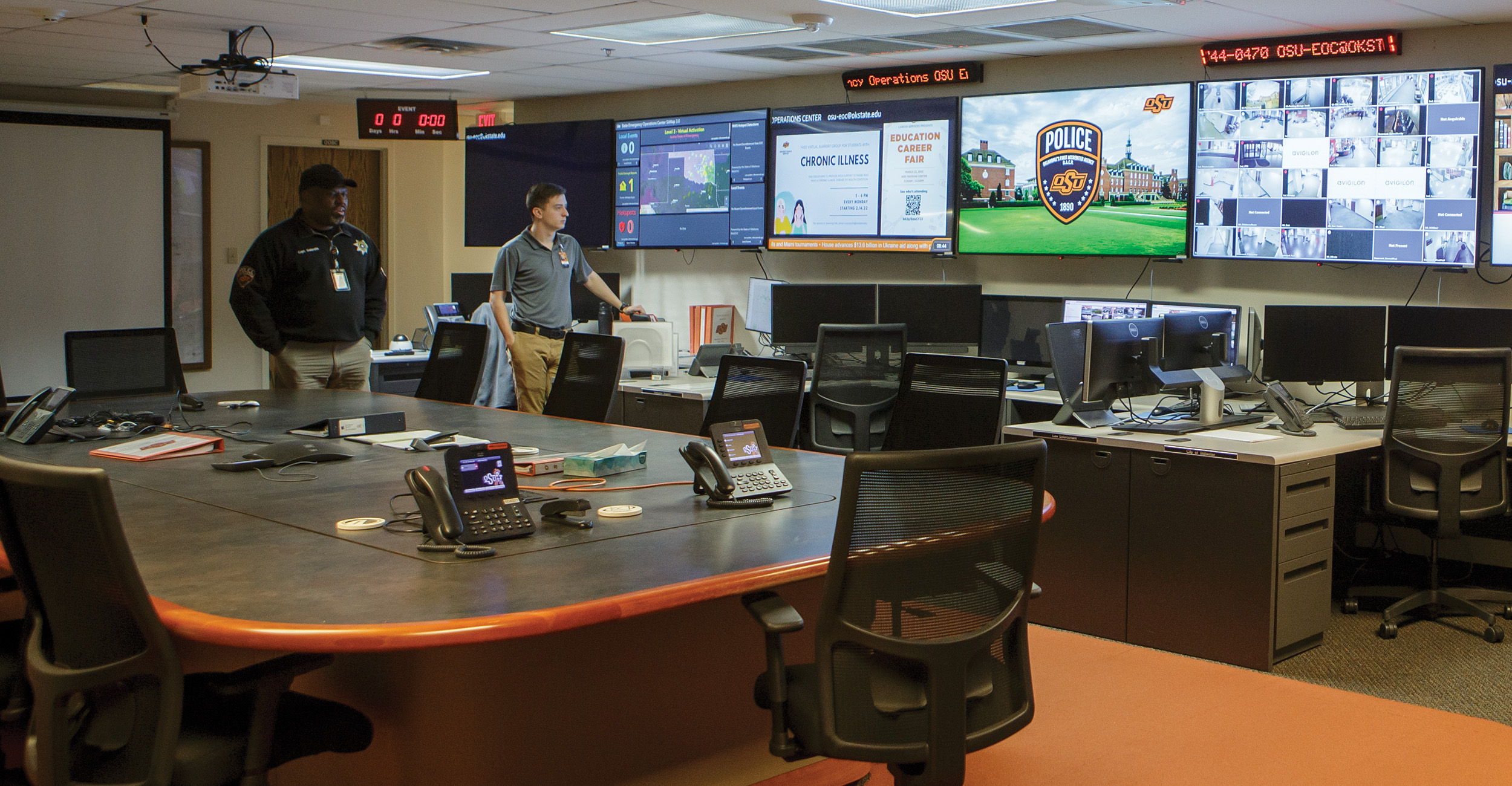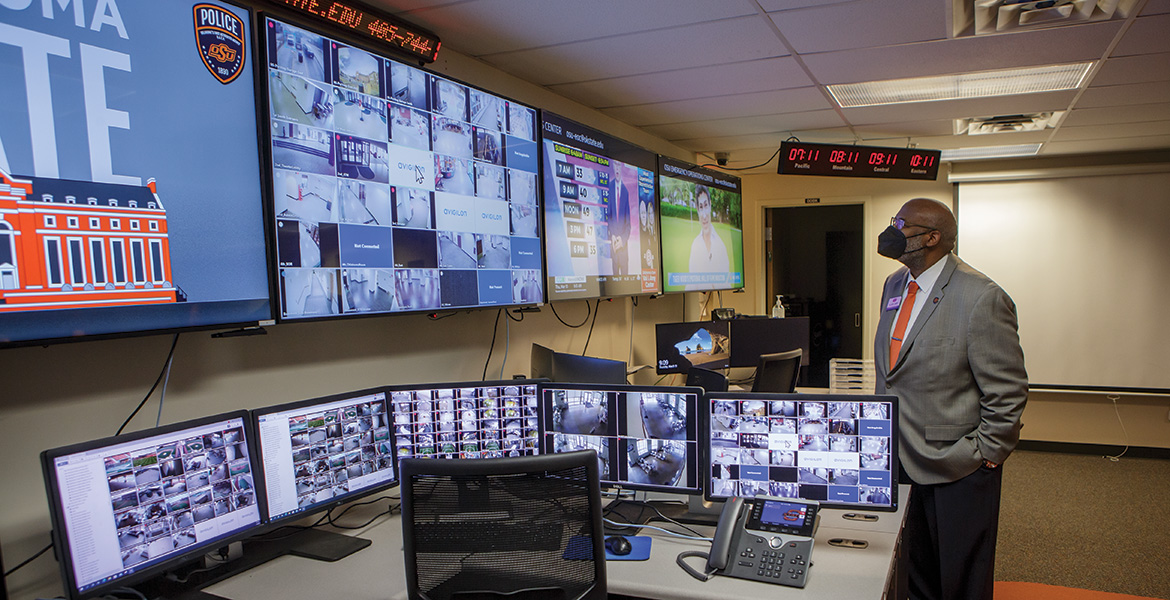
OSU Emergency Operations Center the key to crisis response
Wednesday, April 27, 2022
Media Contact: Mack Burke | Editorial Coordinator | 405-744-5540 | editor@okstate.edu
For many universities, the base of operations during an emergency is a conference room that happens to be vacant at the time.
For Oklahoma State University, it’s a carefully designed basement suite with dedicated laptops, hard-wired phones, security camera access and more, in place and ready to go 24/7 since 2007.
Thanks to a $50,000 gift from the Office of the Vice President for Research, the Emergency Operations Center’s computer systems are updated and the room has wireless capability.
Vice President for Research Kenneth Sewell became intimately acquainted with the EOC when it was the base of operations for the incident management team charged with standing-up and supporting OSU’s COVID-19 human testing lab in the early days of the pandemic.
“OSU’s Emergency Operations Center is structured behind the scenes to keep the OSU and Stillwater communities safe every single day,” Dr. Sewell said. “This EOC facility and team played critical roles at the beginning of the pandemic, allowing our team to safely and securely build OSU’s SARS-CoV-2 testing capabilities. I’m delighted to help keep the EOC technology up-to-date to ensure their effectiveness in future crises.”
Whether a potential emergency is sudden and extreme — like a tornado barreling through campus — or the space becomes the hub of operations for a coordinated effort like the creation of the COVID-19 lab, crucial operational questions are already answered because of the EOC. There are no decisions of where to go and what to take; those plans have already been made and executed.
The EOC was created after the Virginia Tech shooting in 2007. The spot was centrally located, underground and was being used for storage.
Ron Hill, now retired, was hired in 2008 as the first emergency operations manager. He previously served as chief of operations and deputy director for the State of Oklahoma Emergency Management. Hill was involved in responding to incidents such as the bombing of the Alfred P. Murrah building; the May 3, 1999, tornado outbreak; the I-40 bridge collapse; and multiple natural disasters.
By the time Hill arrived, the space had been cleared and walls erected. Hill designated smaller rooms around the primary meeting space for the smooth flow of operation based on the National Incident Management System: operations, planning, logistics and finance.
Hill ordered a custom table to transform the main room. On a typical day, it functions as a conference table. In the event of an emergency, the center of the table rises, revealing phones, computers and printed resources. University leaders can show up with only the clothes on their backs and have all the tools necessary to respond to a crisis.
“The table was built and assembled in Canada, then dismantled into seven pieces, wrapped in bubble wrap and shipped to Stillwater where a crew came to assemble it. It took eight hours,” Hill said. “It was designed specifically to fit through the doorways with back-up electronics under the table and pre-wired for networking.”
One side of the main room is lined with computers — stations of operation for partners like the City of Stillwater and its police and fire departments — the wall above them lined with televisions, making it possible to watch campus security cameras, see what television news stations are reporting, communicate with Oklahoma’s Office of Emergency Management, or connect a computer to broadcast a list of needs or notes on the changing situation. The EOC is often activated during severe weather events. Emergency responders work directly with a meteorologist from the National Weather Service and can monitor the NWS as well as the university’s lightning detection system.
OSU police dispatch moved into the EOC in 2019.
“It’s much more protected in its new location,” said Mike Robinson, OSU’s director of public safety. “The EOC gives us a base from which to conduct emergency operations that’s hardened and secure. In the event we did have a catastrophic event that damaged the campus, chances are we would still be able to operate from the EOC.”
OSU Police Department Capt. Dan Ray said the usefulness of the EOC as a base of operation is enhanced by campus partnerships.
“Oklahoma State has the added benefit of a fire protection and emergency management program known around the world,” Ray said. “We rely heavily on students and faculty for their expertise in emergency management. During the operation of the COVID-19 incident management team, several members of the emergency management program stepped up to fill key roles defined by the National Incident Management System.”

OSU’s Unmanned Systems Research Institute has also become a significant emergency management partner. When floods threatened campus in 2019, USRI flew unmanned vehicles (more commonly known as drones) over campus to provide a real-time look at the encroaching water with images livestreamed to the EOC.
For events with large crowds like America’s Greatest Homecoming and Cowboy football games, the EOC is activated.
On game days, two dispatchers operate out of Boone Pickens Stadium with representatives from multiple OSU, Stillwater, Payne County and state emergency response departments like the Oklahoma State Bureau of Investigation and FBI. The dispatchers in the stadium handle calls within the walls of BPS. Dispatchers in the EOC take care of calls outside the stadium. Ray and the university public information officer are also stationed in the EOC.
"When the game is over, or if there were an emergency, the transition of incident management to the EOC is seamless,” Ray said. “As individuals transition from the stadium, we can pick up the ball and have continuity of service until they all get over here.”
In 2019, a tactical communication station was added in the main room near the table of leaders.
“In an emergency situation, the key leaders want to go where the freshest information is so they can make the best informed decision possible,” Ray said. “The freshest information is with the dispatchers, but the last thing the dispatchers need is someone leaning over their shoulders. We created the tactical communication station that can hear and receive all the same information as the dispatchers and provide that in real time to the decision makers.”
The EOC is a constantly evolving little-known hub of critical operations. Updates made possible by the VPR’s office have kept the space up-to-date with technological advancements.
“Anyone who has had an opportunity to need the EOC and see what’s possible, appreciates it,” said OSU PD Chief Leon Jones. “We cannot thank VP Sewell enough for recognizing that value and investing in it. The EOC is a safety net for the university.”
Photos By: Gary Lawson
Story By: Shannon Rigsby | STATE Magazine
